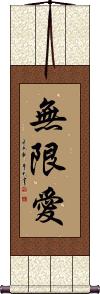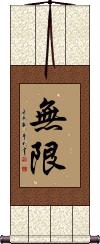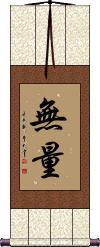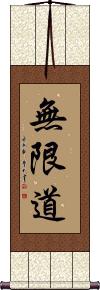Many custom options...
And formats...

Unlimited in Chinese / Japanese...
Buy an Unlimited calligraphy wall scroll here!
Personalize your custom “Unlimited” project by clicking the button next to your favorite “Unlimited” title below...
Greatest Infinite Love
Infinite Love
Infinity / Infinite / Unlimited / Unbounded
Japanese = Infinity / Chinese = No limits
無限 is the Chinese and Japanese word meaning infinity, unlimited or unbounded.
無限 literally translates as “without limits” or “without [being] bound.”
The first character means “never” or “not,” like the prefix “un-.”
The second means “limited,” “restricted,” or “bound.”
Please note that the Japanese definition leans more toward “infinity” and the Chinese is more about being “boundless” or “without limits.”
In Korean, this means infinity, infinitude, or boundlessness. But in Korean, this term has many interpretations or contexts, so your intended meaning might be vague or ambiguous.
Immeasurable / Unlimited
This Chinese, Japanese, and old Korean word means measureless, uncountable, unlimited, or immeasurable.
Mugendo
These search terms might be related to Unlimited:
Greatest Infinite Love
In the Abyss of Infinite Bitterness - Turn to the Shore
Infinite Love
Infinity / Infinite / Endless / Boundless
Infinity / Infinite / Unlimited / Unbounded
Not the results for unlimited that you were looking for?
Below are some entries from our dictionary that may match your unlimited search...
| Characters If shown, 2nd row is Simp. Chinese |
Pronunciation Romanization |
Simple Dictionary Definition |
如來 如来 see styles |
rú lái ru2 lai2 ju lai nyorai にょらい |
More info & calligraphy: Tathagata(out-dated kanji) Tathagata; perfected one (suffix of high-ranking Buddhist deities) tathāgata, 多陀阿伽陀 q. v.; 怛他揭多 defined as he who comes as do all other Buddhas; or as he who took the 眞如 zhenru or absolute way of cause and effect, and attained to perfect wisdom; or as the absolute come; one of the highest titles of a Buddha. It is the Buddha in his nirmāṇakāya, i. e. his 'transformation' or corporeal manifestation descended on earth. The two kinds of Tathāgata are (1) 在纏 the Tathāgata in bonds, i. e. limited and subject to the delusions and sufferings of life, and (2) 出纏 unlimited and free from them. There are numerous sutras and śāstras bearing this title of 如來 rulai. |
無量 无量 see styles |
wú liàng wu2 liang4 wu liang muryou / muryo むりょう |
More info & calligraphy: Immeasurable / Unlimited(adj-no,n) immeasurable; infinite; inestimable; (given name) Muryō apramāṇa; amita; ananta; immeasurable, unlimited, e.g. the 'four infinite' characteristics of a bodhisattva are 慈悲喜捨 kindness, pity, joy, and self-sacrifice. |
無限 无限 see styles |
wú xiàn wu2 xian4 wu hsien mugen むげん |
More info & calligraphy: Infinity / Infinite / Unlimited / Unbounded(1) infinity; infinitude; eternity; (adj-no,adj-na) (2) infinite; limitless; (given name) Mugen infinite |
識 识 see styles |
zhì zhi4 chih shiki しき |
to record; to write a footnote (1) acquaintanceship; (2) {Buddh} vijnana; consciousness; (3) (after a signature) written by...; (personal name) Tsuguhide vijñāna, "the art of distinguishing, or perceiving, or recognizing, discerning, understanding, comprehending, distinction, intelligence, knowledge, science, learning . . . wisdom." M.W. parijñāna, "perception, thorough knowledge," etc. M.W. It is intp. by 心 the mind, mental discernment, perception, in contrast with the object discerned; also by 了別 understanding and discrimination. There are classifications of 一識 that all things are the one mind, or are metaphysical; 二識 q. v. discriminating the ālaya-vijñāna or primal undivided condition from the mano-vijñāna or that of discrimination; 三識 in the Laṅkāvatāra Sutra, fundamental, manifested and discriminate; 五識 q.v. in the 起信論, i.e. 業, 轉, 現, 知, and 相續識; 六識 the perceptions and discernings of the six organs of sense; also of 8, 9, 10, and 11 識. The most important is the eight of the 起信論, i.e. the perceptions of the six organs of sense, eye, ear, nose, tongue, body (or touch), and mind, together with manas, intp. as 意識 the consciousness of the previous moment, on which the other six depend; the eighth is the ālaya-vijñāna, v. 阿賴耶, in which is contained the seed or stock of all phenomena and which 無沒 loses none, or nothing, is indestructible; a substitute for the seventh is ādāna 'receiving' of the 唯識, which is intp. as 無解 undiscriminated, or indefinite perception; there is a difference of view between the 相 and the 性 schools in regard to the seventh and eight 識; and the latter school add a ninth called the amala, or pure vijñāna, i.e. the non-phenomenal 眞如識. The esoterics add that all phenomena are mental and all things are the one mind, hence the one mind is 無量識 unlimited mind or knowledge, every kind of knowledge, or omniscience. vijñāna is one of the twelve nidānas.; Ālaya-vijñāna and mano-vijñāna; i. e. 阿梨耶 | and 分別事 |; v. 識. |
佛土 see styles |
fó tǔ fo2 tu3 fo t`u fo tu butsudo |
buddhakṣetra. 佛國; 紇差怛羅; 差多羅; 刹怛利耶; 佛刹 The land or realm of a Buddha. The land of the Buddha's birth, India. A Buddha-realm in process of transformation, or transformed. A spiritual Buddha-realm. The Tiantai Sect evolved the idea of four spheres: (1) 同居之國土 Where common beings and saints dwell together, divided into (a) a realm where all beings are subject to transmigration and (b) the Pure Land. (2) 方便有餘土 or 變易土 The sphere where beings are still subject to higher forms of transmigration, the abode of Hīnayāna saints, i.e. srota-āpanna 須陀洹; sakṛdāgāmin 斯陀含; anāgāmin 阿那含; arhat 阿羅漢. (3) 實報無障礙 Final unlimited reward, the Bodhisattva realm. (4) 常寂光土 Where permanent tranquility and enlightenment reign, Buddha-parinirvāṇa. |
化佛 see styles |
huà fó hua4 fo2 hua fo kebutsu |
nirmāṇabuddha, an incarnate, or metamorphosed Buddha: Buddhas and bodhisattvas have universal and unlimited powers of appearance, v. 神通力. |
十智 see styles |
shí zhì shi2 zhi4 shih chih jū chi |
The ten forms of understanding. I. Hīnayāna: (1) 世俗智 common understanding; (2) 法智 enlightened understanding, i.e. on the Four Truths in this life; (3) 類智 ditto, applied to the two upper realms 上二界; (4), (5), (6), (7) understanding re each of the Four Truths separately, both in the upper and lower realms, e.g. 苦智; (8) 他心智 understanding of the minds of others; (9) 盡智 the understanding that puts an end to all previous faith in or for self, i.e. 自信智; (10) 無生智 nirvāṇa wisdom; v. 倶舍論 26. II. Mahāyāna. A Tathāgatas ten powers of understanding or wisdom: (1) 三世智 perfect understanding of past, present, and future; (2) ditto of Buddha Law; (3) 法界無礙智 unimpeded understanding of the whole Buddha-realm; (4) 法界無邊智 unlimited, or infinite understanding of the whole Buddha-realm; (5) 充滿一切智 understanding of ubiquity; (6) 普照一切世間智 understanding of universal enlightenment; (7) 住持一切世界智 understanding of omnipotence, or universal control; (8) 知一切衆生智 understanding of omniscience re all living beings; (9) 知一切法智 understanding of omniscience re the laws of universal salvation; (10) 知無邊諸佛智 understanding of omniscience re all Buddha wisdom. v. 華嚴経 16. There are also his ten forms of understanding of the "Five Seas" 五海 of worlds, living beings, karma, passions, and Buddhas. |
大乘 see styles |
dà shèng da4 sheng4 ta sheng oonori おおのり |
Mahayana, the Great Vehicle; Buddhism based on the Mayahana sutras, as spread to Central Asia, China and beyond; also pr. [Da4 cheng2] (surname) Oonori Mahāyāna; also called 上乘; 妙乘; 勝乘; 無上乘; 無上上乘; 不惡乘; 無等乘, 無等等乘; 摩訶衍 The great yāna, wain, or conveyance, or the greater vehicle in comparison with the 小乘 Hīnayāna. It indicates universalism, or Salvation for all, for all are Buddha and will attain bodhi. It is the form of Buddhism prevalent in Tibet, Mongolia, China, Korea, Japan, and in other places in the Far East. It is also called Northern Buddhism. It is interpreted as 大教 the greater teaching as compared with 小教 the smaller, or inferior. Hīnayāna, which is undoubtedly nearer to the original teaching of the Buddha, is unfairly described as an endeavour to seek nirvana through an ash-covered body, an extinguished intellect, and solitariness; its followers are sravakas and pratyekabuddhas (i.e. those who are striving for their own deliverance through ascetic works). Mahāyāna, on the other hand, is described as seeking to find and extend all knowledge, and, in certain schools, to lead all to Buddhahood. It has a conception of an Eternal Buddha, or Buddhahood as Eternal (Adi-Buddha), but its especial doctrines are, inter alia, (a) the bodhisattvas 菩薩 , i.e. beings who deny themselves final Nirvana until, according to their vows, they have first saved all the living; (b) salvation by faith in, or invocation of the Buddhas or bodhisattvas; (c) Paradise as a nirvana of bliss in the company of Buddhas, bodhisattvas, saints, and believers. Hīnayāna is sometimes described as 自利 self-benefiting, and Mahāyāna as 自利利他 self-benefit for the benefit of others, unlimited altruism and pity being the theory of Mahāyāna. There is a further division into one-yana and three-yanas: the trīyāna may be śrāvaka, pratyeka-buddha, and bodhisattva, represented by a goat, deer, or bullock cart; the one-yāna is that represented by the Lotus School as the one doctrine of the Buddha, which had been variously taught by him according to the capacity of his hearers, v. 方便. Though Mahāyāna tendencies are seen in later forms of the older Buddhism, the foundation of Mahāyāna has been attributed to Nāgārjuna 龍樹. "The characteristics of this system are an excess of transcendental speculation tending to abstract nihilism, and the substitution of fanciful degrees of meditation and contemplation (v. Samādhi and Dhyāna) in place of the practical asceticism of the Hīnayāna school."[Eitel 68-9.] Two of its foundation books are the 起信論and the 妙法蓮華經 but a larnge numberof Mahāyāna sutras are ascribed to the Buddha。. |
天眼 see styles |
tiān yǎn tian1 yan3 t`ien yen tien yen tengen; tengan てんげん; てんがん |
nickname of the FAST radio telescope (in Guizhou) (1) {Buddh} (See 五眼) the heavenly eye; (2) (てんがん only) (rare) rolling back one's eyes during convulsions; (given name) Tengan divyacakṣṣus. The deva-eye; the first abhijñā, v. 六通; one of the five classes of eyes; divine sight, unlimited vision; all things are open to it, large and small, near and distant, the destiny of all beings in future rebirths. It may be obtained among men by their human eyes through the practice of meditation 修得: and as a reward or natural possession by those born in the deva heavens 報得. Cf 天耳, etc. |
普門 普门 see styles |
pǔ mén pu3 men2 p`u men pu men fumon ふもん |
(surname) Fumon Universal door, the opening into all things, or universality; the universe in anything; the unlimited doors open to a Buddha, or bodhisattva, and the forms in which he can reveal himself. |
浩茫 see styles |
hào máng hao4 mang2 hao mang |
boundless; unlimited |
無方 无方 see styles |
wú fāng wu2 fang1 wu fang muhō |
No place, nowhere; unlimited to place or method, i.e. Buddha's power. |
無期 无期 see styles |
wú qī wu2 qi1 wu ch`i wu chi muki むき |
unspecified period; in the indefinite future; no fixed time; indefinite sentence (i.e. life imprisonment) (adj-no,n) (1) (ant: 有期) indefinite; unlimited; (2) (abbreviation) (See 無期懲役) life imprisonment |
無際 无际 see styles |
wú jì wu2 ji4 wu chi musai |
limitless; boundless Unlimited.; Unlimited, boundless. |
七種辯 七种辩 see styles |
qī zhǒng biàn qi1 zhong3 bian4 ch`i chung pien chi chung pien shichishu ben |
The seven rhetorical powers or methods of bodhisattvas :― direct and unimpeded; acute and deep; unlimited in scope; irrefutable; appropriate, or according to receptivity; purposive or objective (i.e. nirvana); proving the universal supreme method of attainment, i.e. Mahayana. |
三退屈 see styles |
sān tuì qū san1 tui4 qu1 san t`ui ch`ü san tui chü sant aikutsu |
The three feelings of oppression that make for a bodhisattva's recreancy— the vastness of bodhi; the unlimited call to sacrifice; the uncertainty of final perseverance. There are 三事練磨 three modes of training against them. |
化他壽 化他寿 see styles |
huà tā shòu hua4 ta1 shou4 hua t`a shou hua ta shou ketaju |
A Buddha's long or 'eternal' life spent in saving others; implying his powers of unlimited salvation. |
吃到飽 吃到饱 see styles |
chī dào bǎo chi1 dao4 bao3 ch`ih tao pao chih tao pao |
(Tw) all-you-can-eat (food); (fig.) unlimited usage (digital services etc) |
四梵住 see styles |
sì fàn zhù si4 fan4 zhu4 ssu fan chu shi bonjū |
The noble state of unlimited 慈, 悲, 喜, 捨 love, pity, joy, and indifference. |
四空定 see styles |
sì kōng dìng si4 kong1 ding4 ssu k`ung ting ssu kung ting shi kūjō |
四無色定 The last four of the twelve dhyānas; the auto-hypnotic, or ecstatic entry into the four states represented by the four dhyāna heavens, i. e. 四 空 處 supra. In the first, the mind becomes void and vast like space; in the second, the powers of perception and understanding are unlimited; in the third, the discriminative powers of mind are subdued; in the fourth, the realm of consciousness or knowledge) without thought is reached, e. g. intuitive wisdom. These four are considered both as states of dhyāna, and as heavens into which one who practices these forms of dhyāna may be born. |
無制限 see styles |
museigen / musegen むせいげん |
(adj-no,adj-na,n) unlimited; unrestricted; limitless |
無邊行 无边行 see styles |
wú biān xíng wu2 bian1 xing2 wu pien hsing muhen gyō |
Unlimited Practice |
無限期 无限期 see styles |
wú xiàn qī wu2 xian4 qi1 wu hsien ch`i wu hsien chi |
indefinitely; of unlimited duration |
見放題 see styles |
mihoudai / mihodai みほうだい |
unlimited viewing; watching as much as one likes |
阿彌陀 阿弥陀 see styles |
ā mí tuó a1 mi2 tuo2 a mi t`o a mi to Amida あみだ |
(out-dated kanji) (1) (Buddhist term) Amitabha (Buddha); Amida; (2) (kana only) (abbreviation) ghostleg lottery; ladder lottery; lottery in which participants trace a line across a lattice pattern to determine the winner; (3) (kana only) (abbreviation) wearing a hat pushed back on one's head (阿彌) amita, boundless, infinite; tr. by 無量 immeasurable. The Buddha of infinite qualities, known as 阿彌陀婆 (or 阿彌陀佛) Amitābha, tr. 無量光 boundless light; 阿彌陀廋斯Amitāyus, tr. 無量壽 boundless age, or life; and among the esoteric sects Amṛta 甘露 (甘露王) sweet-dew (king). An imaginary being unknown to ancient Buddhism, possibly of Persian or Iranian origin, who has eclipsed the historical Buddha in becoming the most popular divinity in the Mahāyāna pantheon. His name indicates an idealization rather than an historic personality, the idea of eternal light and life. The origin and date of the concept are unknown, but he has always been associated with the west, where in his Paradise, Suikhāvatī, the Western Pure Land, he receives to unbounded happiness all who call upon his name (cf. the Pure Lands 淨土 of Maitreya and Akṣobhya). This is consequent on his forty-eight vows, especially the eighteenth, in which he vows to refuse Buddhahood until he has saved all living beings to his Paradise, except those who had committed the five unpardonable sins, or were guilty of blasphemy against the Faith. While his Paradise is theoretically only a stage on the way to rebirth in the final joys of nirvana, it is popularly considered as the final resting-place of those who cry na-mo a-mi-to-fo, or blessed be, or adoration to, Amita Buddha. The 淨土 Pure-land (Jap. Jōdo) sect is especially devoted to this cult, which arises chiefly out of the Sukhāvatīvyūha, but Amita is referred to in many other texts and recognized, with differing interpretations and emphasis, by the other sects. Eitel attributes the first preaching of the dogma to 'a priest from Tokhara' in A. D.147, and says that Faxian and Xuanzang make no mention of the cult. But the Chinese pilgrim 慧日Huiri says he found it prevalent in India 702-719. The first translation of the Amitāyus Sutra, circa A.D. 223-253, had disappeared when the Kaiyuan catalogue was compiled A.D. 730. The eighteenth vow occurs in the tr. by Dharmarakṣa A.D. 308. With Amita is closely associated Avalokiteśvara, who is also considered as his incarnation, and appears crowned with, or bearing the image of Amita. In the trinity of Amita, Avalokiteśvara appears on his left and Mahāsthāmaprāpta on his right. Another group, of five, includes Kṣitigarbha and Nāgārjuna, the latter counted as the second patriarch of the Pure Land sect. One who calls on the name of Amitābha is styled 阿彌陀聖 a saint of Amitābha. Amitābha is one of the Five 'dhyāni buddhas' 五佛, q.v. He has many titles, amongst which are the following twelve relating to him as Buddha of light, also his title of eternal life: 無量光佛Buddha of boundless light; 無邊光佛 Buddha of unlimited light; 無礙光佛 Buddha of irresistible light; 無對光佛 Buddha of incomparable light; 燄王光佛 Buddha of yama or flame-king light; 淸淨光佛 Buddha of pure light; 歡喜光佛 Buddha of joyous light; 智慧光佛 Buddha of wisdom light; 不斷光佛 Buddha of unending light; 難思光佛 Buddha of inconceivable light; 無稱光佛Buddha of indescribable light; 超日月光佛 Buddha of light surpassing that of sun and moon; 無量壽 Buddha of boundless age. As buddha he has, of course, all the attributes of a buddha, including the trikāya, or 法報化身, about which in re Amita there are differences of opinion in the various schools. His esoteric germ-letter is hrīḥ, and he has specific manual-signs. Cf. 阿彌陀經, of which with commentaries there are numerous editions. |
五分法身 see styles |
wǔ fēn fǎ shēn wu3 fen1 fa3 shen1 wu fen fa shen gobun hosshin |
pañca-dharmakāya, the five attributes of the dharmakāya or 'spiritual' body of the Tathāgata, i. e. 戒 that he is above all moral conditions; 定 tranquil and apart from all false ideas; 慧 wise and omniscient; 解脫 free, unlimited, unconditioned, which is the state of nirvana; 解脫知見 that he has perfect knowledge of this state. These five attributes surpass all conditions of form, or the five skandhas; Eitel interprets this by exemption from all materiality (rūpa); all sensations (vedana); all consciousness (saṃjñā); all moral activity (karman); all knowledge (vijñāna). The esoteric sect has its own group. See also 五種法身. |
五種法身 五种法身 see styles |
wǔ zhǒng fǎ shēn wu3 zhong3 fa3 shen1 wu chung fa shen goshu hosshin |
The five kinds of a Buddha's dharmakāya. There are four groups. I. (1) 如如智法身 the spiritual body of bhūtatathatā-wisdom; (2) 功德法身 of all virtuous achievement; (3) 自法身 of incarnation in the world; (4) 變化法身 of unlimited powers of transformation; (5) 虛空法身 of unlimited space; the first and second are defined as saṃbhogakāya, the third and fourth as nirmāṇakāya, and the fifth as the dharmakāya, but all are included under dharmakāya as it possesses all the others. II. The esoteric cult uses the first four and adds as fifth 法界身 indicating the universe as pan-Buddha. III. Huayan gives (1) 法性生身 the body or person of Buddha born from the dharma-nature. (2) 功德生身 the dharmakāya evolved by Buddha virtue, or achievement; (3) 變化法身 the dharmakāya with unlimited powers of transformation; (4) 實相法身 the real dharmakāya; (5) 虛 空法身 the universal dharmakāya. IV. Hīnayāna defines them as 五分法身 q. v. |
使い放題 see styles |
tsukaihoudai / tsukaihodai つかいほうだい |
unlimited use; using as much as one likes |
六度無極 六度无极 see styles |
liù dù wú jí liu4 du4 wu2 ji2 liu tu wu chi rokudo mugoku |
The six infinite means of crossing the sea of mortality, i. e. the six pāramitās 六度. |
六根淸淨 六根淸净 see styles |
liù gēn qīng jìng liu4 gen1 qing1 jing4 liu ken ch`ing ching liu ken ching ching rokkon shōjō |
The six organs and their purification in order to develop their unlimited power and interchange, as in the case of a Buddha. This full development enables e. g. the eye to see everything in a great chiliocosm from its highest heaven down to its lowest hells and all the beings past, present, and future, with all the karma of each. |
Click here for more unlimited results from our dictionary
The following table may be helpful for those studying Chinese or Japanese...
| Title | Characters | Romaji (Romanized Japanese) | Various forms of Romanized Chinese | |
| Greatest Infinite Love | 無限大の愛 | bu gen dai no ai bugendainoai | ||
| Infinite Love | 無限愛 无限爱 | mu gen ai / mugenai | wú xiàn ài wu2 xian4 ai4 wu xian ai wuxianai | wu hsien ai wuhsienai |
| Infinity Infinite Unlimited Unbounded | 無限 无限 | mu gen / mugen | wú xiàn / wu2 xian4 / wu xian / wuxian | wu hsien / wuhsien |
| Immeasurable Unlimited | 無量 无量 | muryou / muryo | wú liàng / wu2 liang4 / wu liang / wuliang | |
| Mugendo | 無限道 无限道 | mu gen do / mugendo | wú xiàn dào wu2 xian4 dao4 wu xian dao wuxiandao | wu hsien tao wuhsientao |
| In some entries above you will see that characters have different versions above and below a line. In these cases, the characters above the line are Traditional Chinese, while the ones below are Simplified Chinese. | ||||
Successful Chinese Character and Japanese Kanji calligraphy searches within the last few hours...








